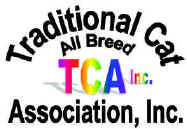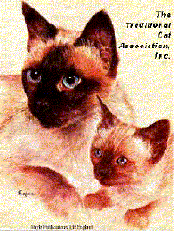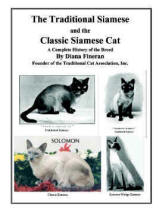THE
AUTHENTIC BENGAL
CAT FAQs
Authentic Bengal Cat Breeders
|

|
Click on small picture
to enlarge |

|
Links to past
Newsletter articles:
Introducing the
Bengal Cat
Coat Patterns and Colors
Purpose of the Bengal Cat League
Bengal Cat Ancestry
Q: What is a Bengal Cat?
by Karin Donoyan
A: Bengal cats are the result of the cross between leopard cats (Asian
Leopard Cat, ALC) and domestic cats, usually Egyptian Mau or Domestic Shorthair,
and subsequent generations of their offspring. The Bengals’ leopard cat
ancestors are the size of domestic cats and are commonly found in the wild over
most of Asia. Bengal cats are medium sized cats with muscular build and a
strikingly spotted, rosetted, or marbled pattern, reminiscent of that of a wild
cat. The most popular color combination is black or very dark brown pattern on a
rich, warm brown, rufous or sandy-beige background. The breed standard for the
Authentic Bengal Cat emphasizes resemblance in conformation and pattern to the
leopard cat, while allowing color combinations, such as seal lynx point pattern
on beige, light-brown or sorrel pattern on tan, and black pattern on silver or
pearly-while, which are not found on wild leopard cats. The Bengals’ fur is
often luxuriously soft and frequently has glitter or sheen to it.
What is the Bengal temperament like?
by Karin Donoyan
This is a question often asked. The early generation Bengals have much of the
wild heritage in them and should be considered as breeders or pets only on an
individual basis, meaning, the particular preference of the prospective owner
and the temperament of the specific Bengal. Many people prefer the F1 and F2
(first and second generation hybrids) personality to all others, and breeders
often choose to include an F1 or F2 female in their breeding program. Third
generation Bengals and beyond may be evaluated along the same lines as other
breeds, for pets or as breeders.
Bengals are highly intelligent. They like to have close contact with people
and are very entertaining, because they love to play and will find something to
occupy themselves. They bond strongly to their owners, either individuals or
whole families, in an almost dog-like fashion. Many learn to walk on a leash, to
fetch, and to ride in cars. Bengals love water. They like to play in it or with
it and many join their owners in the shower or bath tub. They are not lap cats.
Though a favorite person is allowed to hold his or her Bengal for a while, the
Bengal prefers to sit on or near "his" person at his own discretion.
The Authentic Bengal Cat League
by Karin Donoyan
The ABC League is a membership organization, devoted to the welfare of the
Bengal breed. The purpose of the Authentic Bengal Cat League is:
"To promote and maintain leopard cat conformation and appearance in the
Bengal breed standard.
To preserve and recreate the beauty of the Asian Leopard Cat in the Bengals
in case there comes a time when the wild cats are no longer in existence.
To unite Bengal breeders and owners who feel strongly about these goals into
a league which keeps its membership informed of all matters concerning the
Bengal breed and which becomes a strong factor in making changes for the
better."
Annual membership dues are $25.00 for USA, $30.00 for Canada and $35.00 for
Europe and include a quarterly newsletter. Please apply to:
ABCL
c/o Karin Donoyan
25708 Alsea Hwy
Alsea, OR 97324 |
ABCL
c/o Jane Lee
2400 Vauxhall Rd.
Union, NJ 07083 |
Q: What is the Bengal temperament like?
by Diana Fineran
A: They are active, curious and busy. No bookcase is too
high. No drawer is too secure for its energetic examination. Enthusiastic
owners rave about their personality, which they claim is not aggressive
in any way. Bengals are loving, friendly, dependable, docile, full of life,
responsive to people, and very intelligent. Tricks are leaned quickly,
such as jumping over a stick, fetching, rolling over, sitting up and shaking
hands. Playful well into old age, they do like their freedom. Typically
they don't like to be held. An attitude toward running water is legendary.
Some will even go swimming with their owners! Since the Leopard Cat has
an elimination habit of defecating in water, this heritage means many Bengals
can be taught to use the toilet.
|

|
Click on the pictures
to enlarge |

|
Q: What is the color pattern of the Bengal?
by Diana Fineran
A: Their spots are aligned horizontally rather than in
tabby or random configuration. Of high importance is the contrast between
the spots and the background color. The edges must be sharp and the pattern
distinct. The spots can be brown, black, tan, cinnamon or chocolate in
the background of any of the brown spotted tabby colors. Belly fur must
be spotted at well. An occasional Bengal has the recessive "glitter gene",
which causes the fur to have an iridescent glow, as if covered with warm
frost. It is particularly magnificent in the sun light.
The Snow Leopard color has an ivory background with dark
markings very much like the real Snow Leopard.
The Marbled Bengal has bright patches or streaks of three
separate colors.
There also is a Snow Marbled, which is very fascinating.
|

|
THE AUTHENTIC
BENGAL CAT
|

|
Top of Page
Last Updated:
07/20/24 |

 The
Traditional Cat Association,
Inc.©1987®TM
Official Website
The
Traditional Cat Association,
Inc.©1987®TM
Official Website





